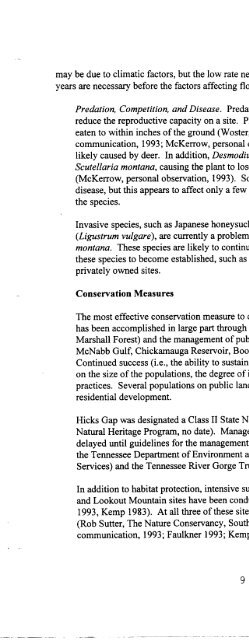Large-flowered Skullcap Recovery Plan - U.S. Fish and Wildlife ...
Large-flowered Skullcap Recovery Plan - U.S. Fish and Wildlife ...
Large-flowered Skullcap Recovery Plan - U.S. Fish and Wildlife ...
Create successful ePaper yourself
Turn your PDF publications into a flip-book with our unique Google optimized e-Paper software.
may be due to climatic factors, but the low rate needs to be studied. Observations over several<br />
years are necessary before the factors affecting flowering <strong>and</strong> seed set can be determined.<br />
Predation, Competition, <strong>and</strong> Disease. Predation of mature plants prior to seed set may<br />
reduce the reproductive capacity on a site. <strong>Plan</strong>ts have been observed that have been<br />
eaten to within inches ofthe ground (Woster, Chattahoochee National Forest, personal<br />
communication, 1993; McKerrow, personal observation, 1993). This damage was most<br />
likely caused by deer. In addition, Desmodium sp. <strong>and</strong> vines have been seen growing on<br />
Scutellaria montana, causing the plant to lose some of its flowers prior to seed set<br />
(McKerrow, personal observation, 1993). Some individual plants have been affected by<br />
disease, but this appears to affect only a few individuals <strong>and</strong> not be a significant threat to<br />
the species.<br />
Invasive species, such as Japanese honeysuckle (Lonicerajaponica) <strong>and</strong> privet<br />
(Ligustrum vulgare), are currently a problem for some populations ofScutellaria<br />
montana. These species are likely to continue to be a problem where disturbance allows<br />
these species to become established, such as on some smaller public areas <strong>and</strong> on<br />
privately owned sites.<br />
Conservation Measures<br />
The most effective conservation measure to date has been the protection ofhabitat. This<br />
has been accomplished in large part through l<strong>and</strong> acquisition (Kellys Ferry Slopes,<br />
Marshall Forest) <strong>and</strong> the management of public l<strong>and</strong> as natural areas (Hicks Gap, Bill<br />
McNabb Gulf, Chickamauga Reservoir, Booker T. Washington, <strong>and</strong> Lookout Mountain).<br />
Continued success (i.e., the ability to sustain populations of Scutellaria montana) depends<br />
on the size ofthe populations, the degree ofisolation of the site, <strong>and</strong> future management<br />
practices. Several populations on public l<strong>and</strong> are “isl<strong>and</strong>s” surrounded by water <strong>and</strong><br />
residential development.<br />
Hicks Gap was designated a Class II State Natural-Scientific Area in 1989 (Tennessee<br />
Natural Heritage Program, no date). Management activities other than hunting are being<br />
delayed until guidelines for the management of the area are developed in cooperation with<br />
the Tennessee Department of Environment <strong>and</strong> Conservation (Division ofEcological<br />
Services) <strong>and</strong> the Tennessee River Gorge Trust (Tennessee Division ofForestry 1990).<br />
In addition to habitat protection, intensive surveys of the Marion County, Marshall Forest,<br />
<strong>and</strong> Lookout Mountain sites have been conducted (Faulkner 1993, McKerrow <strong>and</strong> Pyne<br />
1993, Kemp 1983). At all three of these sites, long-term monitoring has been proposed<br />
(Rob Sutter, TheNature Conservancy, Southeast Regional Office, personal<br />
communication, 1993; Faulkner 1993; Kemp 1983).<br />
9

















